ASRock X79 Extreme11 Review: PCIe 3.0 x16/x16/x16/x16 and LSI 8-Way SAS/SATA
by Ian Cutress on September 3, 2012 10:15 AM EST- Posted in
- Motherboards
- ASRock
- X79
- LSI
- PLX
Notes About CPU Performance
In our recent reviews, we have discussed at length the impact of what is called 'MultiCore Enhancement' or MCE. Please read our discussion article about this technology here. The effect of this technology is extra MHz under full loading at stock settings - i.e. the speed you get out of your processor is affected by the motherboard you purchase. The board applies a small OC to the processor in effect, which increases power draw but should still be within the limits of the hardware being used. This 'feature' is relatively new, but it does mean that some motherboards have a CPU advantage.
The following motherboards are known to have this feature:
- ASUS: X79 and Z77
- Gigabyte: Z77
- ASRock: Z77 OC Formula (later BIOS)
- EVGA: Z77 FTW (later BIOS)
In this case, ASRock have decided not to apply it to the X79 Extreme11 in this review.
3D Movement Algorithm Test
The algorithms in 3DPM employ both uniform random number generation or normal distribution random number generation, and vary in various amounts of trigonometric operations, conditional statements, generation and rejection, fused operations, etc. The benchmark runs through six algorithms for a specified number of particles and steps, and calculates the speed of each algorithm, then sums them all for a final score. This is an example of a real world situation that a computational scientist may find themselves in, rather than a pure synthetic benchmark. The benchmark is also parallel between particles simulated, and we test the single thread performance as well as the multi-threaded performance.
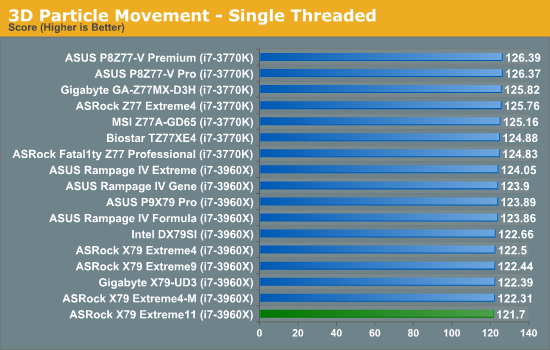
In single threaded performance, there is a clear separation between Z77 and X79, though not by much. ASRock's algorithm for ramping up the CPU speed seems a little flawed, as their boards tend to fall towards the bottom of the rankings.
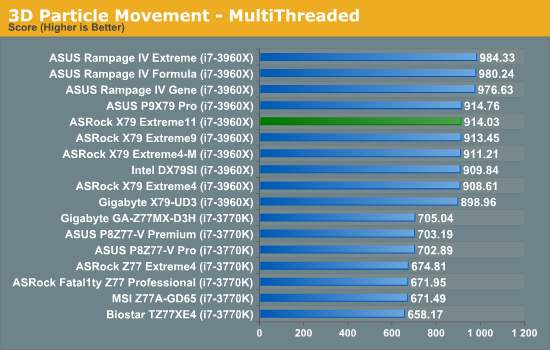
In terms of multithreaded performance, the ASRock X79 Extreme11 takes a standard place for a non-MCE enabled X79 board.
WinRAR x64 3.93 - link
With 64-bit WinRAR, we compress the set of files used in the USB speed tests. WinRAR x64 3.93 attempts to use multithreading when possible, and provides as a good test for when a system has variable threaded load. If a system has multiple speeds to invoke at different loading, the switching between those speeds will determine how well the system will do.
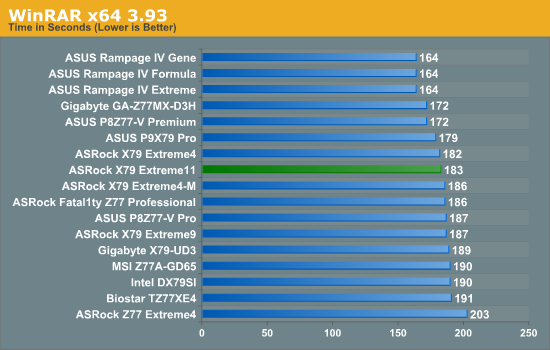
Due to the variable multithreaded nature of WinRAR, MCE enabled boards and those with aggressive ratio changing setting do well here. The ASRock X79 Extreme11 in contrast sits in the middle of the pack.
FastStone Image Viewer 4.2 - link
FastStone Image Viewer is a free piece of software I have been using for quite a few years now. It allows quick viewing of flat images, as well as resizing, changing color depth, adding simple text or simple filters. It also has a bulk image conversion tool, which we use here. The software currently operates only in single-thread mode, which should change in later versions of the software. For this test, we convert a series of 170 files, of various resolutions, dimensions and types (of a total size of 163MB), all to the .gif format of 640x480 dimensions.
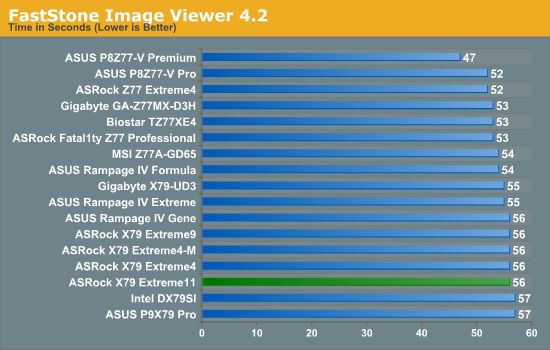
Xilisoft Video Converter
With XVC, users can convert any type of normal video to any compatible format for smartphones, tablets and other devices. By default, it uses all available threads on the system, and in the presence of appropriate graphics cards, can utilize CUDA for NVIDIA GPUs as well as AMD APP for AMD GPUs. For this test, we use a set of 32 HD videos, each lasting 30 seconds, and convert them from 1080p to an iPod H.264 video format using just the CPU. The time taken to convert these videos gives us our result.
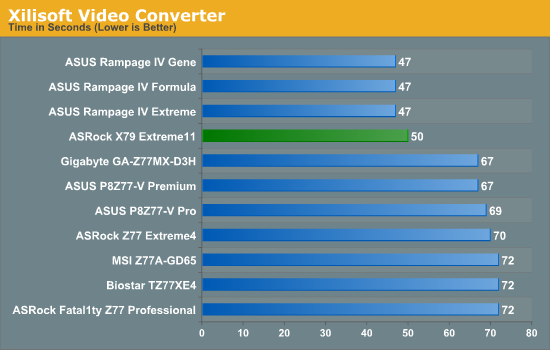
As XVC loves cores and MHz speed, so X79 with a 6C/12T CPU beats all Z77 and 4C/8T CPUs, and MCE wins out. Though the ASRock only loses 3 seconds to the ROG boards, showcasing that for a workstation based on CPU performance, X79 is the top choice.
x264 HD Benchmark
The x264 HD Benchmark uses a common HD encoding tool to process an HD MPEG2 source at 1280x720 at 3963 Kbps. This test represents a standardized result which can be compared across other reviews, and is dependant on both CPU power and memory speed. The benchmark performs a 2-pass encode, and the results shown are the average of each pass performed four times.
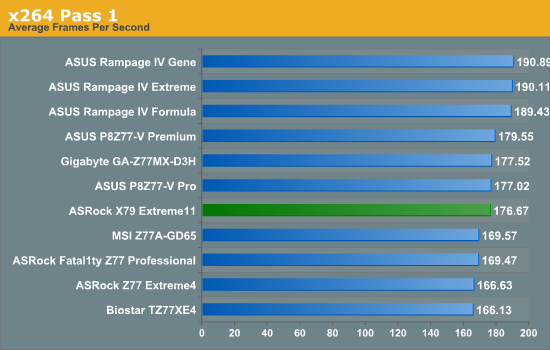
The variable nature of the first pass of our test shows that MHz counts more than cores - MCE enabled boards win here.

The second pass in contrast loves cores and MHz, with distinct separation between X79 and Z77, the separation between MCE and non-MCE boards.










62 Comments
View All Comments
Azethoth - Monday, September 3, 2012 - link
"a SAS". "an" is for words starting with vowels like "an error", "a" is for words starting with consonants like "a Serial Attached SCSI" or "a Storage Area Network" or "a SAS"*. It rolls off the tongue better when you don't have adjacent vowels.*Your particular English implementation may have different rules, these were the ones I grew up with. I find them simple and easy to apply.
lukarak - Tuesday, September 4, 2012 - link
That's not entirely true.It would be an 'a' if you read it as 'a sas'. But with SAS, we usually pronounce it as S A S, and then it goes with 'an'.
ahar - Tuesday, September 4, 2012 - link
Who's "we"? It doesn't include me. Why use three syllables when one will do?Do you also talk about R A M, or R A I D arrays, or an L A N?
Death666Angel - Tuesday, September 4, 2012 - link
Like lukarak said, that is not true. The English language uses "an", when the word following it starts with a vowel sound. That doesn't necessarily mean it has a vowel as the first character (see hour).As for abbreviations, there is no rule for it. Some people pronounce them like a single word, others don't. I use LAN, RAM, RAID as a word, but pronounce SAS as S.A.S. and SATA as S.ATA for example and SNES as S.NES. You can't appease both groups. So I think the writer of the article should go with whatever he feels most comfortable with, so that he avoids flipping between things unconsciously.
Death666Angel - Monday, September 3, 2012 - link
"If you believe the leaks/news online about an upcoming single slot GTX670, or want to purchase several single slot FirePro cards, then the ASRock will give you all that bandwidth as long as the user handles the heat."I'd probably slap some water coolers on there. Insane setup :D.
tynopik - Monday, September 3, 2012 - link
Is it even confirmed that this Ivy Bridge-E is coming out?shunya901 - Monday, September 3, 2012 - link
..............\.............\....http://www.frankfushi.com/
commonprosperity.org@hotmail.com
== ( http://commonprosperity.org )==
you can find many cheap and fashion stuff
jordan air max oakland raiders $30–39;
Ed Hardy AF JUICY POLO Bikini $20;
Handbags (Coach lv fendi d&g) $30
T shirts (Polo ,edhardy,lacoste) $15
Jean(True Religion,edhardy,coogi) $30
Sunglasses (Oakey,coach,gucci,Armaini) $15
New era cap $15
ypsylon - Tuesday, September 4, 2012 - link
But little is delivered.1. Primitive RAID option. Without even small cache it is as useful as Intel Storage Matrix RAID. Of course for R 1/10 parity calculations are not required so lack of XOR chip isn't an issue, but believe me even 128 MB of cache would improve performance greatly.
2. They bolted 8 SATA/SAS ports to the board instead using standard server oriented SFF-8087 connector. You get one cable running 4 drives not 4 separate cables for each separate drive. Very clumsy solution. And very, very cheap. Exactly what I expect of ASR.
3. If someone wants RAID buy a proper hardware controller, even for simple setups of R1/10 - plenty of choice on the market. When you change the board in the future you just unplug controller from old board and plug it into new one. No configuration is needed, all arrays remain the same. Idea of running RAID off the motherboard is truly hilarious, especially if somebody change boards every year or two.
4. Fan on south bridge (or the only bridge as north bridge is in the CPU now? ;) ). Have mercy!
5. They pretend it is WS oriented board yet they equip it with lame Broadcom NICs. Completely clueless, that kind of inept reasoning is really typical of ASRock.
6.And finally why persist with ATX. At least E-ATX would be better choice. Spacing some elements wouldn't hurt. Especially with 7 full PCI-Ex slots. Impossible to replace RAM when top slot is occupied, and with really big VGAs it really is tight squeeze between CPU, RAM and VGA. Why not drop top slot to allow air to circulate. Without proper cooling in the case there will be a pocket of hot air which will never move.
To sum up. Bloody expensive, dumb implementation of certain things, and cheaply made. Like 99% of ASRock products. Cheap Chinese fake dressed like Rolls-Royce. In short:stay away.
dgingeri - Tuesday, September 4, 2012 - link
1. Many server manufacturers equip their small business servers with a low end chip like that because of cost. Small businesses, like those who would build their own workstation class machines, have to deal with a limited budget. This works for this market space.2. I don't see any sign of a SFF-8087 port or cable. I see only SATA ports. Honestly, I would have preferred a SFF-8087 port/cable, as my Dell H200 in my Poweredge T110 II uses. It would take up less real estate on the board and be more manageable. I know this from experience.
3. Yeah, the Dell H200 (or it's replacement H310) has plenty of ports (8) and runs <$200 yet any hardware raid controller with a cache would run $400 for 4 ports or about $600 for 8. (I have a 3ware 9750 in my main machine that ran me $600.) Depending on your target market, cost could matter. They get what they can with the budget they have.
4. I'd have to agree with you on the fan, but there's also the little matter of keeping clearance for the video cards top populate the slots. Take off the decorative plate and make the heatsink bigger, and they could probably do without the fan. Unfortunately, there are lots of stupid people out there who buy things on looks rather than capability.
5. Broadcom NICs are vastly superior to the Realtek or Atheros NICs we usually see on DIY boards. I would be happier to see Intel NICs, but Broadcom is still the second best on the market. I have 2 dual port Broadcom NICs in my Dell T110 II machine (which I use as a VMWare ESXI box to train up for certification and my home server.)They work quite well, as long as you don't use link aggregation.
6. Many people wouldn't be able to afford a case that would handle E-ATX, especially the target market for this board.
For the target market, DIY part time IT guy for a small business trying to make a decent CAD station or graphics workstation, it would work fairly well. I'm just not sure about the reliability factor, which would cost a small business big time. I'd say stay away just on that factor. Do with a little less speed and more reliability if you want to stay in business. Dell makes some nice IB workstations that would be perfectly reliable, but wouldn't be as speedy as a SB-E machine.
08solsticegxp - Sunday, June 9, 2013 - link
You have to realize, this board is not a server board. If it was designed for that, I'm sure they would have two sockets. Also, it is much cheaper to add the LSI chip to the board than have it as an add-on card. If it was an add-on card... where do you expect it to go when using 4 Video cards?I think the board is designed very well for what it was intended for. You may want to consider looking at design as it relates to the intended purpose... Not, some other purpose.
I will agree to say I would have liked to see a Raid 5 option on the RAID controller. However, looking at the price of an LSI (who are noted for being a high quality RAID controller) it is pretty pricey when you start getting to the controllers that have RAID 5 as an option.